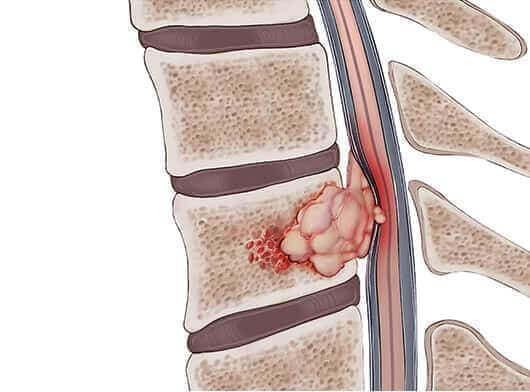- Surgery
- Radiation
- Medical Oncology
- Depending on the type of Spine tumour and its location, surgery may include one or more of the following procedures:
- Decompression: The removal of the entire tumour or part of it. This may involve debulking (reducing the size), an excision (complete removal), or resection (partial removal) to decompress or relieve pressure on the spinal cord and nerve roots. This aids in reducing pain and other Signs & symptoms of spine tumours.
- A spinal tumour that develops within or invades a vertebra may cause bony compression or a fracture. While kyphoplasty and vertebroplasty are two procedures that provide immediate fracture stabilisation.
- Kyphoplasty uses orthopaedic balloons that are inserted into the fracture, inflated to create a hole or cavity, and removed before a bone cement is injected.
- Vertebroplasty does not use balloons. However, a newer technique combines vertebroplasty with radiofrequency (RF) ablation to remove the tumour tissue and create a cavity for the bone cement. RF ablation uses radio waves to break the tumour's cellular and molecular bonds to help remove tissue and create the cavity.
- Spinal stabilisation may be combined with other surgical procedures to treat the tumour. Stabilisation usually involves spinal instrumentation and a bone graft. Instrumentation may include the placement of implants such as rods, interbody devices, and screws to immediately stabilise the spine.
- A bone graft, either taken from your body (autograft) or a donor (allograft), helps stimulate the growth of new bone to join (fuse) the spinal segment together as it heals. Fusion occurs when new bone growth joins vertebrae together.
- Spinal decompression and stabilisation may be performed as a Robot-assisted or minimally invasive procedure or by using a traditional open approach which involves a longer incision and longer recovery time.
-
This may be used to eliminate the remnants of tumours that remain after surgery, to treat inoperable tumours or to treat those tumours where surgery is too risky. Medications may help ease some of the side effects of radiation, such as nausea and vomiting.
Sometimes, the radiation therapy regimen may be adjusted to help minimise the amount of healthy tissue that's damaged and to make the treatment more effective. Modifications may range from simply changing the dosage of radiation to using sophisticated techniques such as 3-D Conformal Radiation Therapy.
CyberKnife is a non-surgical procedure that is precisely targeted radiation to treat certain spine tumours. This treatment is administered during one or more sessions using high-dose of radiation. The effects of the treatment are visible over a period of time and do not appear immediately, as in the case of conventional surgery.
- Chemotherapy uses medications to destroy cancer cells or stop them from growing. The treatment prescribed would depend upon the histology of the diagnosed tumour. The doctor will also decide if chemotherapy needs to be given along with radiation or as a standalone treatment option.



.png)
